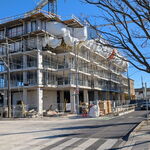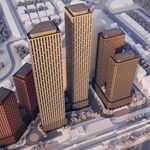LOSTOntario
New Member
Good eye!
Have a look at Humberline just south of Finch West, and you can see the remains of pavement that's directly aligned with the bulk of Humberline's alignment, suggesting that the road used to go straight.
...James
Here is a photo I took in 1987 showing Humberline south of Finch. It was a dirt road at that time and did peter out as it went south, although it went all the way into the valley. The curbs were new at the time as they were just starting the development south of Finch. At the time, I could not find evidence that it ever bridged the Humber River, however if you look on Google Maps you can clearly see the alignment straight through to the road that is the entrance to Woodbine Racetrack. The remaining visual evidence on Google Maps is wider than just a trail, so perhaps it did in fact at one time bridge the Humber. I would be interested in finding out, and plan a visit there soon to gather more evidence. If you follow that alignment, the bridge would have been in a direct line north of the Woodbine entrance north of existing condo building.

Bridge would be at spot marked with white arrow:

...and as James pointed out interestingly enough, if you follow the exact alignment of the Woodbine entrance road across the racetrack it aligns perfectly with Carlingview Drive, which then aligns perfectly with Renforth Drive which DID have a straight alignment prior to the 427 interchange.
Last edited:








